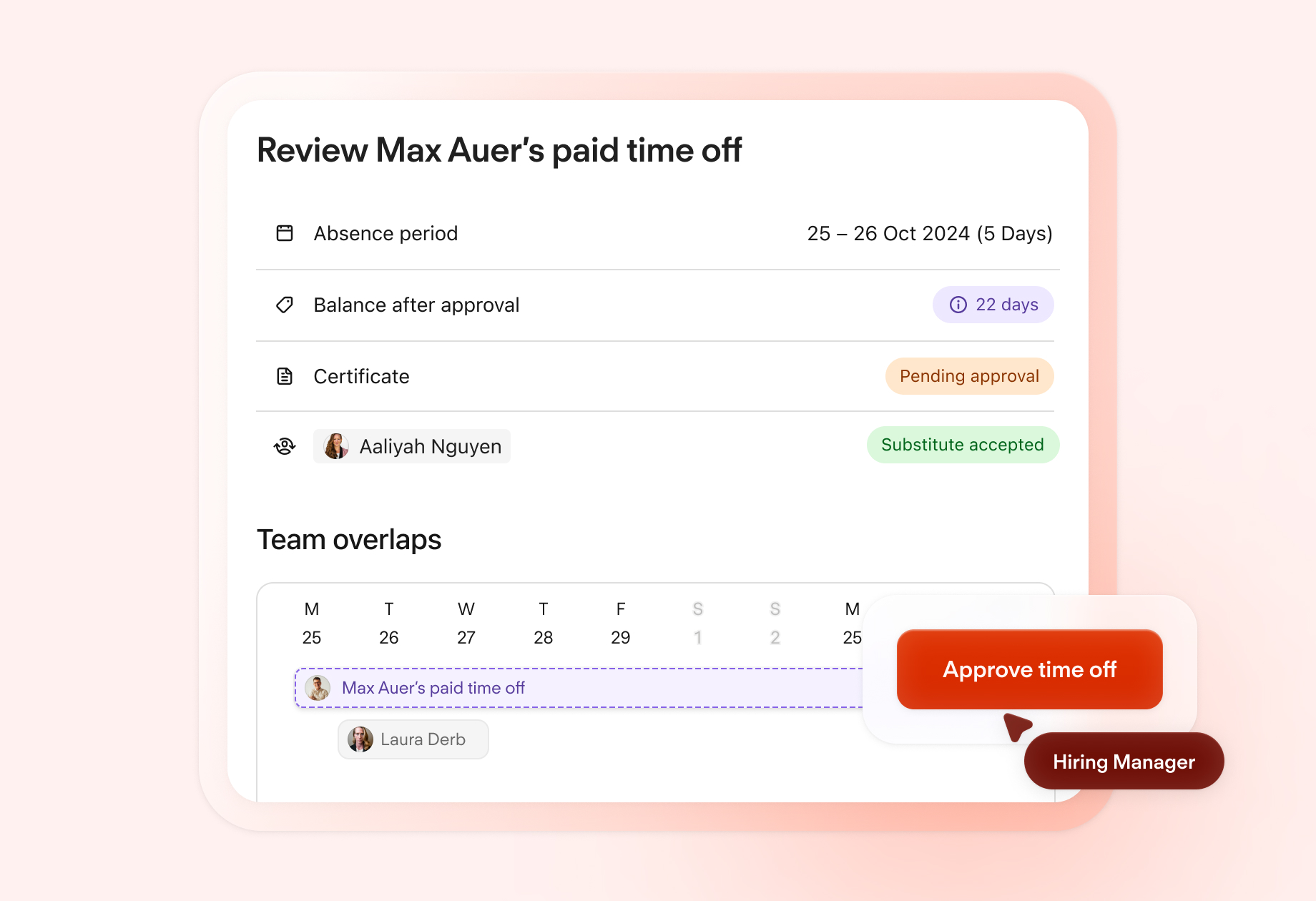Keeping in touch (KIT) days: A guide for employers

Keeping in touch (KIT) days allow employees on maternity leave to maintain a sense of connection with their work, stay updated on industry trends and keep their skills and knowledge fresh. Read on for our full guide to KIT days for employers.
We wrote the definitive guide to people strategies. Your copy is waiting for you.What are KIT days?
Keeping in touch (KIT) days are days that employees can work while they’re on adoption or maternity leave. This allows them to stay connected to work without ending their leave or losing their right to statutory maternity pay (SMP) or statutory adoption pay (SAP).
KIT days are completely optional on both sides: Employers don’t have to offer KIT days, and employees don’t have to take them. As an employer, you should discuss the possibility of KIT days with your employees before they go on leave.
How do KIT days work?
Employees can work a maximum of 10 KIT days, which they can take at any time apart from during the two weeks of compulsory maternity leave immediately after the birth or adoption of their child (four weeks for factory workers). The 10-day limit is the same whether the employee usually works full-time or part-time.
KIT days can be taken during paid or unpaid leave, and they don’t have to be taken on consecutive days. In practice, employees often use their KIT days to gradually transition back into full-time work at the end of their leave. For example, they might work two days per week for their last five weeks of leave.
A word of warning: any day that your employee works during their maternity or adoption leave counts as a KIT day, even if they only work for a few hours. That means you can’t split your employees’ KIT days up, for example by having them work twenty half-days.
KIT days and SPLIT days
SPLIT days are additional days that employees can work if they choose to take shared parental leave (SPL). Employees on SPL are entitled to 20 SPLIT days in addition to their 10 KIT days.
Why are KIT days important?
Going on maternity or adoption leave usually means taking several months off work. During that time, employees sometimes find that their skills and knowledge get a bit rusty — especially with the stress of having a new baby to take care of. They might also feel disconnected from their work and their colleagues while they’re away.
All of this means that coming back to work after their leave is over can be overwhelming for an employee. They have to catch up on any changes that have taken place within the company or the industry and brush up on skills that they might not have used for several months.
KIT days solve all of these problems by allowing employees to maintain a sense of connection with their work while they’re on leave. This makes it much easier for them to return to work after their leave is over.
Review, approve and track absences from one place: Personio

Seamless absence management that scales with your headcount. See how Personio can manage every type of leave for your organisation today.
Absences with PersonioBenefits of KIT days for employers and employees
Below are some of the benefits that KIT days can bring to both employers and employees.
For employers
For employers, KIT days can:
Improve employee relations: Offering your employees the opportunity to take KIT days during their maternity or adoption leave shows them that you haven’t forgotten about them just because they’re not there. It tells employees that you want to support them in their return to work and make it as smooth and easy as possible.
Keeps employee skills up to date: KIT days help ensure that employees’ skills and knowledge are kept fresh during their absence. This means they don’t have to spend too long re-learning these skills once they get back to work.
Improves productivity and morale: Employees who use their KIT days typically find it easier to quickly get back up to productivity when they return from maternity leave. KIT days can also help with employee morale, since trying to pick everything up after an extended absence could otherwise be stressful.
For employees
For employees, KIT days can:
Reduce stress and anxiety: Returning to work after a long period can be an anxiety-inducing experience for an employee. They might worry that they’ll no longer be able to work as effectively as they used to, especially if they’re a new parent. Working a few KIT days before fully returning to work can help employees feel less overwhelmed on their first day back.
Ease the transition back to work: Many employees use their KIT days to work part-time during their last few weeks of parental leave. This gives them time to work out any problems they might have (for example with transport, working hours or childcare), so they’re ready to work when their leave ends.
Get them back into the mindset for work: Having a new baby is a huge change, and your employee probably hasn’t had much time to think about work while they’ve been away. Working a few days before the end of their leave helps to get them back in the right mindset for work, so they’re ready to jump straight in after their leave ends.
How to implement a KIT day policy in your workplace: 5 questions to consider
While there’s no obligation for employers to have a formal policy for KIT days, it can help to ensure that employees are treated fairly and consistently. It can also be reassuring for employees to understand what KIT days will look like at your organisation if they choose to take them.
Here are a few questions that you should think about while building your policy:
1. How many KIT days will employees be allowed to take?
Employees can take a maximum of 10 KIT days without ending their maternity or adoption leave. However, they don’t have to work this many. It’s important to find the right balance between supporting your employees in their gradual transition back into work, and overwhelming them while they’re still on leave.
2. How will KIT days be requested and approved?
It’s a good idea to determine how you want employees to request a KIT day, and how you’ll approve it. For example, will they be free to use their KIT days however they choose, or do you want them to put in a request with their manager ahead of time?
3. What types of work can employees do on KIT days?
You should think about whether you want your employees to prioritise anything in particular when they take their KIT days. For example, it could be a good idea for your employees to use their KIT days to attend monthly team meetings so they’re up to date on what’s been going on during their leave.
There are also some things that don’t count as using a KIT day: for example, popping into the office to show off their new baby, or generally communicating with managers or colleagues. Your policy should clearly state what is and isn’t counted as a KIT day.
4. How will KIT days be paid?
There’s no specific guidance on how employees should be paid for KIT days, as long as they receive at least the National Minimum Wage. Remember that statutory maternity pay (SMP) or statutory adoption pay (SAP) doesn’t count towards this — they need to receive at least the minimum wage on top of any SMP or SAP they’re entitled to.
Some employers choose to pay employees for KIT days at their normal rate. They can offset this against SMP or SAP, as long as the employee still receives at least the minimum wage for the hours they worked.
Payment for KIT days should be paid as part of your normal payroll — you can’t wait until your employee returns to work to pay them for their KIT days.
5. Will employees be required to work at home or in the office?
You’ll need to decide with your employees whether you want them to work at home or in the office on their KIT days. Since the purpose of KIT days is to help employees ease back into work, it’s often a good idea to have them work however (and wherever) they normally do.
However, there are also some arguments for asking employees to come into the office for their KIT days, even if they usually work from home. For example, it could make it easier for them to reconnect with colleagues and understand any changes that have taken place in their absence.
KIT days: Additional resources for organisations
Want to learn more about supporting your employees as they enter new phases of their private lives? Check out our articles on maternity leave, occupational maternity pay, paternity leave and shared parental leave to find out everything you need to know.
Track KIT days with Personio

Personio’s all-in-one HR software features an easy-to-use absence management solution that allows your team to track absences of all kinds. That includes giving your employees the opportunity to request KIT days, managers to approve them and HR to monitor them.
All of your organisation’s absences, all from one place. Learn more about Personio today, speak with an expert or dive into our HR software pricing guide to learn more.
